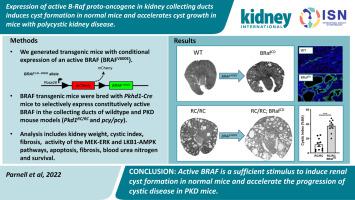Kidney International ( IF 14.8 ) Pub Date : 2022-06-26 , DOI: 10.1016/j.kint.2022.05.028 Stephen C Parnell 1 , Archana Raman 2 , Yan Zhang 3 , Emily A Daniel 3 , Yuqiao Dai 3 , Aditi Khanna 3 , Gail A Reif 3 , Jay L Vivian 4 , Timothy A Fields 4 , Darren P Wallace 5

|
Polycystic kidney disease (PKD) is characterized by the formation and progressive enlargement of fluid-filled cysts due to abnormal cell proliferation. Cyclic AMP agonists, including arginine vasopressin, stimulate ERK-dependent proliferation of cystic cells, but not normal kidney cells. Previously, B-Raf proto-oncogene (BRAF), a MAPK kinase kinase that activates MEK-ERK signaling, was shown to be a central intermediate in the cAMP mitogenic response. However, the role of BRAF on cyst formation and enlargement in vivo had not been demonstrated. To determine if active BRAF induces kidney cyst formation, we generated transgenic mice that conditionally express BRAFV600E, a common activating mutation, and bred them with Pkhd1-Cre mice to express active BRAF in the collecting ducts, a predominant site for cyst formation. Collecting duct expression of BRAFV600E (BRafCD) caused kidney cyst formation as early as three weeks of age. There were increased levels of phosphorylated ERK (p-ERK) and proliferating cell nuclear antigen, a marker for cell proliferation. BRafCD mice developed extensive kidney fibrosis and elevated blood urea nitrogen, indicating a decline in kidney function, by ten weeks of age. BRAFV600E transgenic mice were also bred to Pkd1RC/RC and pcy/pcy mice, well-characterized slowly progressive PKD models. Collecting duct expression of active BRAF markedly increased kidney weight/body weight, cyst number and size, and total cystic area. There were increased p-ERK levels and proliferating cells, immune cell infiltration, interstitial fibrosis, and a decline in kidney function in both these models. Thus, our findings demonstrate that active BRAF is sufficient to induce kidney cyst formation in normal mice and accelerate cystic disease in PKD mice.
中文翻译:

活性 B-Raf 原癌基因在肾集合管中的表达诱导正常小鼠囊肿形成并加速多囊肾病小鼠囊肿生长
多囊肾病 (PKD) 的特征是由于异常细胞增殖导致充满液体的囊肿形成和逐渐增大。环 AMP 激动剂,包括精氨酸加压素,刺激囊性细胞而非正常肾细胞的 ERK 依赖性增殖。以前,B-Raf 原癌基因 (BRAF) 是一种激活 MEK-ERK 信号的 MAPK 激酶,被证明是 cAMP促有丝分裂反应的中心中间体。然而,BRAF在体内尚未得到证实。为了确定活性 BRAF 是否会诱导肾囊肿形成,我们生成了有条件地表达 BRAF V600E(一种常见的激活突变)的转基因小鼠,并将它们与Pkhd1-Cre小鼠在集合管中表达活性 BRAF,这是囊肿形成的主要部位。BRAFV600E (BRaf CD ) 的集合管表达早在三周龄时就引起肾囊肿形成。磷酸化 ERK (p-ERK) 和增殖细胞核抗原(细胞增殖的标志物)水平升高。BRaf CD小鼠在 10 周大时出现广泛的肾纤维化和血尿素氮升高,表明肾功能下降。BRAF V600 E转基因小鼠也被培育成Pkd1 RC/RC和pcy/pcy小鼠,具有良好特征的缓慢进展的 PKD 模型。活性 BRAF 的集合管表达显着增加了肾脏重量/体重、囊肿数量和大小以及总囊性面积。在这两种模型中,p-ERK 水平升高,细胞增殖、免疫细胞浸润、间质纤维化和肾功能下降。因此,我们的研究结果表明,活性 BRAF 足以在正常小鼠中诱导肾囊肿形成并在 PKD 小鼠中加速囊性病变。











































 京公网安备 11010802027423号
京公网安备 11010802027423号